University of Huddersfield
 | |
| Motto | Inspiring tomorrow's professionals |
|---|---|
| Type | Public |
| Established | 1992 -University status 1825 -Huddersfield Science and Mechanics' Institute |
| Endowment | £2.47 m (2015)[1] |
| Chancellor | HRH The Duke of York |
| Vice-Chancellor | Bob Cryan |
Administrative staff | 1,100 academic, 900 support |
| Students | 18,280 (2016/17)[2] |
| Undergraduates | 14,180 (2016/17)[2] |
| Postgraduates | 4,100 (2016/17)[2] |
| Location | Huddersfield , West Yorkshire , England |
| Campus | Semi-urban |
| Colours | Blue |
| Affiliations | University Alliance Association of Commonwealth Universities Universities UK |
| Website | hud.ac.uk |
The University of Huddersfield (informally Huddersfield University) is a public university located in Huddersfield, West Yorkshire, England. It has been a University since 1992, but has its origins in a series of institutions dating back to the 19th century. It has made teaching quality a particular focus of its activities, winning the inaugural Higher Education Academy Global Teaching Excellence Award,[3] and achieving a Teaching Excellence Framework (TEF) Gold Award,[4] both in 2017.
Contents
1 History
1.1 An early failure (1825)
1.2 Young Men's Mental Improvement Society (1841–1843)
1.3 Huddersfield Mechanics' Institution (1844–1883)
1.4 Technical School and Mechanics' Institute (1883–1896)
1.5 Technical College and College of Technology (1896–1970)
1.6 Huddersfield Polytechnic (1970–1992)
1.7 University of Huddersfield (since 1992)
2 Campuses
2.1 Queensgate Campus
2.2 University Campus Oldham
2.3 University Campus Barnsley
2.4 International Study Centre
3 Organisation and governance
3.1 Chancellor
3.2 Senior management
4 Academic profile
4.1 Academic schools
4.2 Research
4.3 Royal connections
5 Student life
5.1 Accommodation
5.2 Students' Union
6 Reputation and rankings
7 References
8 External links
History
The present University of Huddersfield can trace its history back through several predecessor institutions.
An early failure (1825)
In 1825 there was an attempt to set up a Scientific and Mechanics Institution in the town. Supported by a group of donors, its patron was leading Whig and large local landowner Sir John Ramsden. Its aims were to instruct local mechanics and tradesmen in scientific principles relating to their work, through lectures and a circulation library, which by 1827 contained over 700 volumes. The financial crisis of 1825–1826 led to the failure of the institution’s bankers, and it faltered and later became part of the Huddersfield Philosophical Society, an organisation with which its rules now more closely aligned.[5] Some 19th century students earned qualifications as external students of the University of London.[6]
Young Men's Mental Improvement Society (1841–1843)
The history of the University is usually traced to 1841. It was in that year that five young men who were employed by local industrialist Frederic Schwann,[7] who had been born in Frankfurt, approached their employer for support in establishing a new subscription library and some elementary educational classes, ‘to supply in some cases the deficiency of early instruction, and to procure for others the means of further improvement’.[8] They first met in the Temperance Hotel, Cross Church Street, Huddersfield in May 1841. Classes began for the first 40 or so pupils in the room of the British School at Outcote Bank, and were taught by experienced staff from the local Collegiate Schools and businessmen like Schwann. A subscription library was founded, and classes were delivered in Reading, writing, arithmetic, grammar, geography, design and French.
Huddersfield Mechanics' Institution (1844–1883)
The increase in student numbers prompted a move to Nelson's Buildings in New Street, and the renaming of the institution to more closely reflect its remit. The first Secretary, Robert Neil, was appointed in 1844, and acted not just as a Secretary but as a teacher-supervisor, influencing the formative development of the organisation. In March 1844 he organised an Soiree (tea-party) for 700 at the town's Philosophical Hall, and in May a Rural Gala for 500 at Fixby Pastures. Negotiations with the local railway company led to reduced fares into York for 300 membership to enjoy the cultural opportunities of the city.[9] In 1846, Neil was succeeded by George Searle Phillips, who was described by historian John O'Connell as 'philosopher, propagandist and missionary'[8] of the institution. He oversaw expansion of the curriculum, revision of the fee system to make the institution self-supporting, the visitation of absent students and the compilation of statistics of the institution's achievements.
In 1850, growing attendance meant another move, to Wellington Buildings, Queen Street. At this time, a 'Preliminary Savings Bank' scheme was also introduced in the Institution, linked to the Huddersfield Banking Company, which took almost 7000 deposits[10] during its first year of operation. Based on the Scottish system of encouraging working people to make small, regular saving deposits, it was a forerunner of the Post Office Savings Bank, founded in 1861. In 1854, after Phillips resignation, Frank Curzon took over as Secretary and remained in post until 1883. During his tenure a prize giving and distribution ceremony was introduced to reward attendance and good conduct. He not only oversaw a recruitment drive, but also the move to the first purpose built home of the institution, on Northumberland Street. The institution took possession in 1861, as student numbers passed 800 annually.[11]
The continued prosperity of the institution during the 1860s has been attributed to two main developments – the demand for more technical and scientific education, and the introduction of an examination system by the newly formed national Department of Science and Art. The institution managed an examinations system and gave grants to science schools (often based in Mechanics' Institutions) on a 'payment by results' basis. In 1857 the Society of Arts held its first examinations outside London at Huddersfield.[12]
Technical School and Mechanics' Institute (1883–1896)
A merger took place with the town’s Female Educational Institute in 1883, and the institution become the Technical School and Mechanics' Institute. A new building was constructed on what it today the ring road called Queensgate that cost £20,000,[13] and was funded by the subscriptions of members and philanthropic supporters. Called the Ramsden Building, after the Ramsden family who owned the land upon which the building stood, the building is still in use by the Health and Human Sciences Department of the University today. Before the building opened to students in 1884, it was used for a five-month Fine Art and Industrial Exhibition. These kinds of exhibitions, inspired by the Great Exhibition, showcased the latest in textile technology alongside copies of great masters paintings or more contemporary works.
Technical College and College of Technology (1896–1970)
In 1896, the Technical School and Mechanics' Institute became the Technical College, which changed its name in 1958 to become the College of Technology.
World War I was a time of growth for the College. A Coal Tar Chemistry Department was created, funded by the government and by donations which were also used to provide research scholarships in Chemistry. More than 100 chemists worked at the College as research staff as products were created for British Dyes Ltd.[13]
During World War II, the College housed student teachers evacuated from Avery Hill College of Education, Eltham, London (now part of the University of Greenwich), and trained members of the armed forces training to be radio mechanics, engineers, fitters and clerks. Civilians also trained at the College in more basic workshop skills.[13]
One notable visitor to the college in 1964 was Dusty Springfield, who appeared at 'Sound Sixty-Four', an event organised by the Huddersfield Tech students as part of Rag Week.[13]
Huddersfield Polytechnic (1970–1992)
It was the College of Technology which, in 1970, merged with the Oastler College of Education to become Huddersfield Polytechnic. The Oastler College had been founded in 1963, as a day training college for school teachers. Huddersfield Polytechnic was officially inaugurated by the then Education Secretary Margaret Thatcher on 23 April 1971.[13]

David Blunkett studied at Holly Bank College
In 1974, a further merger took place with the Technical Teaching Training College at Holly Bank. That college had been noted in education circles for its policy of training students over the age of 25, one of whom was the future Education Secretary David Blunkett. However, after the merger, it became part of the Polytechnic's Faculty of Education, and those idiosyncrasies were gradually eroded.[14] Teacher training remained on the Holly Bank site until the land was sold by the University in 2001.[15]
The large brown Central Services Building, now known as the Schwann Building, a prominent feature not just of the campus but also the town of Huddersfield itself, was completed in January 1977. The brown colour was chosen so it would better fit in with the local sandstone. The building was officially opened by HRH the Duchess of Kent.[13]
Several high-profile bands played the University's students' union during the late 1970s and early 1980s, including The Stranglers, The Jam and The Undertones.[13]
Former Prime Minister Harold Wilson returned to his hometown in 1983, the same year he stood down as an MP, to open a University building on Firth Street and to deliver a lecture.[13] He would later have a different building named after him on the campus.
University of Huddersfield (since 1992)
The Polytechnic became the University of Huddersfield in 1992.[16]
Professor Ken Durrands was Vice-Chancellor at the time the institution achieved University status. He was later credited with having "transformed" it into "a thriving university".[17] However, in 1994 he was forced to leave his post before the end of his contract, following a row over the removal of independently-elected representatives from the University's governing body.[18]
Sir William Taylor served as Vice-Chancellor for a year during 1994 and 1995. He had previously been the Vice-Chancellor of Hull University. He only intended to remain at Huddersfield for 12 months, on an interim basis.[19]
The next Vice-Chancellor was John Tarrant, appointed in October 1995. He served in the role until 2006, and was later Secretary General of the Association of Commonwealth Universities until his retirement in 2010.[13]
The present Vice-Chancellor, Professor Bob Cryan, took over the job in January 2007. At the time, he was the youngest Vice-Chancellor in the UK. His strategy for the University during this time has been to lead an "inspiring, innovative University of international renown".[20] In May 2007, the University welcomed Queen Elizabeth for a visit to the campus, during which she unveiled the foundation stone for the new Creative Arts Building.[21] The following year, the building was officially opened by HRH the Duke of Kent.[22]
In 2013, the University of Huddersfield was named University of the Year at the Times Higher Education Awards. Accepting the award, Prof Cryan said: "“It is a tribute to all the staff who have worked so hard to get us where we are today. We are now well established as one of the country’s innovative universities – and the best is yet to come.”[23]
The archives of all the university's predecessor institutions are held in Heritage Quay, the University Archive Service based in the Schwann Building.[24] Heritage Quay opened in 2014 and is open to the general public, allowing easier access to both students and non-students to the many collections within University's archives. It received more than £1.5m in Lottery funding, and in 2016 won the Buildings That Inspire category in the Guardian's University Awards.[13]
The University now attracts students from more than 130 countries. With an annual turnover of approximately £150m each year, it estimates it is worth £300m annually to the local economy.[13]
Campuses
Queensgate Campus
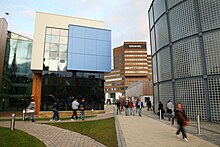
A View of Queensgate Campus
The University's main campus, Queensgate, is south-east of Huddersfield town centre. Virtually all of the University's teaching takes place on the site. The campus is split in two by the Huddersfield Narrow Canal. It features a mixture of converted mill buildings, and purpose-built facilities. More than £250 million has been invested by the University in the campus.[25]
A notable feature of the University of Huddersfield in recent years has been the amount of building work taking place on the Queensgate campus. In addition to the Creative Arts Building which opened in 2008, a new £17 million Business School opened in 2010, followed by the £3 million Buckley Innovation Centre in 2012, the £22.5 million Student Central building in 2014, and the £27.5 million Oastler Building for Law and the School of Music, Humanities and Media, in 2017.[26]
As part of the University's 175th anniversary commemorations in 2016, several of the buildings on the Queensgate campus were renamed after significant figures with connections to the Huddersfield area and the University's predecessor institutions. The distinctive brown Central Services Building was renamed the Schwann Building, after Frederic and Mary Schwann who had been inspired to create the Young Men's Mental Improvement Society in 1841. Other buildings were named for Edith Key, Joseph Priestley, the Brontë sisters and the University's own Chancellor Emeritus, Sir Patrick Stewart.
In a second round of renaming in 2017, other campus buildings were named in honour of Karen Sparck Jones, Dame Caroline Haslett, Sir John Cockcroft, and Charles Sikes.[27]
University Campus Oldham
University Campus Oldham (UCO), located in Oldham, Greater Manchester, opened in May 2005. It offers full and part-time courses at degree, diploma, foundation degree and postgraduate level. Since August 2012 University Campus Oldham (UCO) has been managed by Oldham College. In 2017-2018, UCO Teacher Education programmes continue to be validated by the university, and lead to a University of Huddersfield award.[28]
University Campus Barnsley
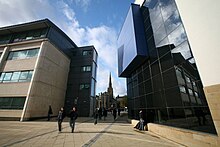
Queensgate Campus
University Campus Barnsley, located in Barnsley, South Yorkshire, opened in 2005. The campus offers facilities for subjects such as music, art and design, journalism and media production. £5.5 million has been invested with the help of the Higher Education Funding Council for England, Yorkshire Forward and Objective 1.
From August 2013 University Campus Barnsley (UCB) has been managed by Barnsley College. UCB programmes starting in September 2013 continue to be validated by the university, and lead to a University of Huddersfield award.
International Study Centre
The International Study Centre (ISC) at the university offers degree preparation courses for international students. The programmes are run by Study Group. The ISC is located on the university’s main Queensgate campus. Students can mix with others and also have access to the library and other specialist IT facilities.[29]
Organisation and governance
Chancellor
The Duke of York replaced actor Sir Patrick Stewart to become the University’s fourth Chancellor in July 2015.[30] The Duke had previously served as the Patron of the University since 2013.[31]
The University's first two Chancellors were Reginald Cross, who held the role between 1992 and 1994, and Sir Ernest Hall, who served between 1996 and 2004.[13]
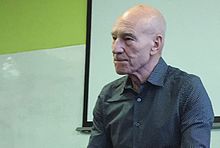
Sir Patrick Stewart meeting students on the University campus in April 2017
Sir Patrick Stewart served as Chancellor for 11 years, having first been appointed in 2004. He has been a regular visitor to the campus, sometimes leading workshops with drama students, in addition to being an overseas ambassador for the University.[32]
One feature of Sir Patrick's tenure as Chancellor was his attendance at summer graduation ceremonies, and his leading of parades of graduates through the town.[33] The first such parade took place in 2008.[34] He has continued his association with the University as Emeritus Chancellor.[35]
In 2016, the building used by the University's Drama department, previously known as the Milton building, was renamed the Sir Patrick Stewart building. He returned to the campus to reopen it.[32]
Senior management
The University is run by the Vice-Chancellor, Professor Bob Cryan. Underneath him is Deputy Vice-Chancellor, Professor Tim Thornton, and three Pro Vice-Chancellors. Each of the seven academic schools is led by a Dean, with an eighth Dean who oversees the Graduate School. Other University services are run by Directors.[36]
Academic profile
Academic schools
The university is organised into the following academic schools:
- Applied Sciences
- Art, Design and Architecture
- Computing and Engineering
- Education and Professional Development
- Business
- Human and Health Sciences
- Music, Humanities and Media
Research
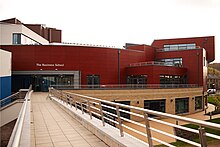
New Business School
The University has world-leading applied research groups in biomedical sciences, engineering and physical sciences, social sciences and arts and humanities. It has quadrupled its research income and its number of postgraduate researchers in recent years.[37]
In the 2014 Research Excellence Framework (REF) exercise, the University of Huddersfield achieved its best ever result. It rose to 68th in the UK Research Power league table, having been placed 97th in the 2008 REF.[38]
More University of Huddersfield academics, 262, were entered than in any previous cycle, and the proportion of world leading research submitted increased to 15%.[38]
The University also host the MIAMI facilities, a world-class laboratory addressed to materials sciences investigations and energy studies.
Royal connections
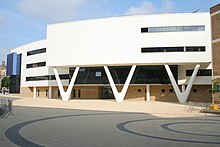
The Creative Arts Building.
The University has developed a significant association with the Royal family in recent years, in particular with the appointment of HRH The Duke of York as Patron in 2013 and later Chancellor in 2015. The University's centre for young entrepreneurs is named for the Duke, and was opened by him in 2013. It is situated on the first floor of the Buckley Innovation Centre, across Firth Street from the main campus.[39]
The Duke's former wife, Sarah, Duchess of York, was in 2016 given the title of Visiting Professor of Philanthropreneurship.[40] Their elder daughter, Princess Beatrice, has also visited the University to meet students and view their work.[41]
The Queen visited the campus in 2007 to lay the foundation stone of the Creative Arts Building. Other royals to have visited the University in the years since include the Princess Royal, who in 2015 opened the new Student Central building, the Duke of Kent and the Duke of Gloucester.[42]
The Prince of Wales visited University Campus Barnsley in 2012.[43]
Student life
Accommodation
The Storthes Hall Park Student Village and Ashenhurst Student Houses are the university affiliated accommodation. These residences are privately owned and operated by Digs Student, independently of the university.
Storthes Hall is situated in a parkland to the south of the town with 1,386 en-suite single, double or disabled bedrooms in shared flats of six to eight students.
Ashenhurst Houses are located in woodlands close to the campus and Storthes Hall Park. There are 280 single bedrooms in shared houses of six to eight students, all with shared facilities including a communal lounge and kitchen/dining area.[44]
Students' Union
The Students' Union represents, supports and advises students on all aspects of their time at university.
The union moved into its new purpose-built Student Central building in January 2014. The building cost £22.5 million and includes an 800-capacity Sports Hall, catering outlets, a shop, offices for the student radio station Radio Hud and magazine T'Hud, and a range of support services including welfare and the careers centre.[45]
There was some controversy when the new building opened as it does not include a bar. Reports suggested the bar in the previous union building had been losing as much as £100,000 a year, with students instead choosing to drink at home or in other nearby pubs and clubs.[46]
Reputation and rankings
| Global rankings | |
|---|---|
QS (2019)[47] | 701–750 |
THE (2019)[48] | 601–800 |
| National rankings | |
Complete (2019)[49] | 60 |
Guardian (2019)[50] | 41 |
Times / Sunday Times (2019)[51] | 65 |
| British Government assessment | |
Teaching Excellence Framework[52] | Gold |
The University has been successful in winning a series of awards in recent years.
It was ranked 701+ in the 2015–16 QS World University Rankings.[53] The University was the Entrepreneurial University of the Year at the THE awards 2012.[54] It won the Outstanding Registry Team 2013 at the THE Leadership and Management awards 2013.[55] The University was University of the Year at the THE awards 2013.[56] In 2014 the University was named the Times Higher Education's (THE) Best University Workplace.[57] The University was the New University of the Year at the Educate North Awards 2015.
In 2016, the University came top among all UK universities for having qualified teaching staff. More than 90% of its academic were found to have a teaching qualification, with the next-highest institution scoring 84%.[58]
References
^ "Archived copy" (PDF). Archived from the original (PDF) on 28 August 2016. Retrieved 31 October 2016.CS1 maint: Archived copy as title (link) .mw-parser-output cite.citationfont-style:inherit.mw-parser-output qquotes:"""""""'""'".mw-parser-output code.cs1-codecolor:inherit;background:inherit;border:inherit;padding:inherit.mw-parser-output .cs1-lock-free abackground:url("//upload.wikimedia.org/wikipedia/commons/thumb/6/65/Lock-green.svg/9px-Lock-green.svg.png")no-repeat;background-position:right .1em center.mw-parser-output .cs1-lock-limited a,.mw-parser-output .cs1-lock-registration abackground:url("//upload.wikimedia.org/wikipedia/commons/thumb/d/d6/Lock-gray-alt-2.svg/9px-Lock-gray-alt-2.svg.png")no-repeat;background-position:right .1em center.mw-parser-output .cs1-lock-subscription abackground:url("//upload.wikimedia.org/wikipedia/commons/thumb/a/aa/Lock-red-alt-2.svg/9px-Lock-red-alt-2.svg.png")no-repeat;background-position:right .1em center.mw-parser-output .cs1-subscription,.mw-parser-output .cs1-registrationcolor:#555.mw-parser-output .cs1-subscription span,.mw-parser-output .cs1-registration spanborder-bottom:1px dotted;cursor:help.mw-parser-output .cs1-hidden-errordisplay:none;font-size:100%.mw-parser-output .cs1-visible-errorfont-size:100%.mw-parser-output .cs1-subscription,.mw-parser-output .cs1-registration,.mw-parser-output .cs1-formatfont-size:95%.mw-parser-output .cs1-kern-left,.mw-parser-output .cs1-kern-wl-leftpadding-left:0.2em.mw-parser-output .cs1-kern-right,.mw-parser-output .cs1-kern-wl-rightpadding-right:0.2em
^ abc "2016/17 Students by HE provider, level, mode and domicile" (CSV). Higher Education Statistics Agency. Retrieved 25 March 2018.
^ "University of Huddersfield wins Global Teaching Excellence Award 2017". Higher Education Academy. Retrieved 25 September 2017.
^ "It's official - Huddersfield Uni is one of the best in the country". Huddersfield Examiner. Retrieved 25 September 2017.
^ Rules of the Huddersfield Scientific and Mechanic Institute for the Promotion of Useful Knowledge (HUD/GV/3)|format=requires|url=(help). 25 April 1825.
^ "Student lists". Archived from the original on 14 September 2010. Retrieved 7 October 2010.
^ "Huddersfield Exposed – John Frederic Schwann". Retrieved 14 December 2016.
^ ab O'Connell, John (2016). The Making of a University: The Path to Higher Education in Huddersfield. University of Huddersfield Press. p. 4.
^ Annual Report 1845. Huddersfield Mechanics' Institution. 1845 (HUD/GV/2/1)|archive-format=requires|archive-url=(help).
^ Annual Report 1852. Huddersfield Mechanics' Institution. 1852. p. 4 (HUD/GV/2/1)|archive-format=requires|archive-url=(help).
^ Annual Report 1862. Huddersfield Mechanics' Institution. 1862. p. 4 (HUD/GV/2/1)|archive-format=requires|archive-url=(help).
^ "Celebrating 160 Years of the Society of Arts (SA) and Royal Society of Arts (RSA) Examinations". Technical Education Matters. Retrieved 14 December 2016.
^ abcdefghijkl "History of the University of Huddersfield: a timeline". University of Huddersfield. Retrieved 6 April 2017.
^ "Family History: Bob Owen's latest book – Memories of Holly Bank". Huddersfield Examiner. 5 November 2011. Retrieved 6 April 2017.
^ Frankland, Peter. "A Brief History of HollyBank". HollyBank. Retrieved 6 April 2017.
^ "Teacher Education at Huddersfield 1947–2007 – University of Huddersfield Online Store". Archived from the original on 16 July 2015. Retrieved 15 July 2015.
^ Hodges, Lucy (2 November 2000). "Blowing the whistle on a vice-chancellor's fiddle". The Independent. Retrieved 6 April 2017.
^ Hodges, Lucy (2 November 2000). "Blowing the whistle on a vice-chancellor's fiddle". The Independent. Retrieved 6 April 2017.
^ "Huddersfield meets wanderer William". Times Higher Education. 11 November 1994. Retrieved 6 April 2017.
^ "Vice-Chancellor Professor Bob Cryan CBE DL FREng". University of Huddersfield. Retrieved 6 April 2017.
^ "Unveiling of the Creative Arts Building foundation stone". University of Huddersfield. Archived from the original on 31 July 2012. Retrieved 6 April 2017.
^ "New Creative Arts Building gets Royal seal of approval when The Duke of Kent visits". University of Huddersfield. Archived from the original on 9 October 2013. Retrieved 6 April 2017.
^ Atkinson, Neil (30 November 2013). "University of Huddersfield is crowned best in Britain". Huddersfield Examiner. Retrieved 6 April 2017.
^ "Heritage Quay | What will you discover?". www.heritagequay.org. Retrieved 14 December 2016.
^ Atkinson, Neil (2 March 2016). "New University of Huddersfield building soars into the sky". Huddersfield Examiner. Retrieved 6 April 2017.
^ "Complete University Guide: Huddersfield". Complete University Guide. Retrieved 6 April 2017.
^ "Renaming Buildings - University of Huddersfield". www.hud.ac.uk. Retrieved 6 October 2017.
^ University Campus Oldham (2016). "Courses - University Campus Oldham". Retrieved 3 February 2018.
^ "University preparation courses in Huddersfield UK". Archived from the original on 3 April 2016. Retrieved 15 July 2015.
^ Press Association (13 July 2015). "Prince Andrew gives Vulcan salute to Patrick Stewart at university ceremony". The Guardian. Retrieved 13 July 2015.
^ "Duke to be patron of university". Batley News.
^ ab "Sir Patrick Stewart says being part of Huddersfield is 'amazing'". Huddersfield Examiner. 9 August 2016. Retrieved 6 April 2017.
^ "No selfies as Patrick Stewart joins students on parade in Huddersfield". Yorkshire Post. 14 July 2014. Retrieved 6 April 2017.
^ Wainwright, Martin (22 July 2008). "Huddersfield graduates: 'I've felt proud parading through the town'". The Guardian. Retrieved 6 April 2017.
^ "The University's Chancellor Sir Patrick Stewart will step down at the July Awards Ceremonies after 12 years in post". University of Huddersfield. 27 March 2015. Archived from the original on 7 April 2017. Retrieved 6 April 2017.
^ "Senior Staff Structure". University of Huddersfield. Retrieved 6 April 2017.
^ "The Complete University Guide: Huddersfield". The Complete University Guide. Retrieved 6 April 2017.
^ ab "Research Excellence Framework 2014". University of Huddersfield. Archived from the original on 6 April 2015. Retrieved 6 April 2017.
^ "The Duke of York Young Entrepreneur Centre". University of Huddersfield. Archived from the original on 9 October 2013. Retrieved 6 April 2017.
^ "Sarah Ferguson is Visiting Professor of Philanthrenreneurship". Female First. 13 July 2016. Retrieved 6 April 2017.
^ "Huddersfield fashion designs receive Royal approval from Princess". University of Huddersfield. 21 December 2016. Archived from the original on 7 April 2017. Retrieved 6 April 2017.
^ "Royal Visits". University of Huddersfield. Archived from the original on 29 February 2012. Retrieved 6 April 2017.
^ "Royal appointment". University of Huddersfield. 24 January 2012. Archived from the original on 7 August 2013. Retrieved 6 April 2017.
^ "Digs Student: Storthes Hall". Digs Student. Retrieved 6 April 2017.
^ Shaw, Martin (20 January 2014). "Huddersfield University unveils new £22.5m Student Central building". Huddersfield Examiner. Retrieved 6 April 2017.
^ Shaw, Martin (23 September 2013). "Huddersfield University Students' Union bar losing £100k a year to be closed". Huddersfield Examiner. Retrieved 6 April 2017.
^ "QS World University Rankings 2019". Quacquarelli Symonds Ltd.
^ "World University Rankings 2019". Times Higher Education.
^ "University League Table 2019". The Complete University Guide.
^ "University league tables 2019". The Guardian. 29 May 2018.
^ "The Times and Sunday Times University Good University Guide 2019". Times Newspapers.
^ "Teaching Excellence Framework outcomes". Higher Education Funding Council for England.
^ "University of Huddersfield". 16 July 2015.
^ "THE Awards Winners 2012". Retrieved 15 July 2015.
^ "Winners". Retrieved 15 July 2015.
^ "2013 Winners :: THE Awards 2013". Archived from the original on 2 December 2013. Retrieved 15 July 2015.
^ "Awards history". Retrieved 31 July 2015.
^ Hirst, Andrew. "University of Huddersfield top of the class when it comes to teaching qualifications". Huddersfield Examiner. Retrieved 6 April 2017.
- New Chancellor for the next generation
- New Student Union building opened.
External links
| Wikimedia Commons has media related to University of Huddersfield. |
- Official University of Huddersfield website
- Official University of Huddersfield Students' Union website
Coordinates: 53°38′36″N 1°46′42″W / 53.64324°N 1.77837°W / 53.64324; -1.77837
